Winston Churchill once told Joseph Stalin “In wartime, truth is so precious that she should always be attended by a bodyguard of lies”. During World War II, the power of these bodyguards, in the form of military deception, became strikingly apparent. The German military was the most technologically advanced force ever encountered. The Germans were the first to use jet-powered aircraft on the battlefield. They created the enigma machine, which proved to be an extremely difficult system to break. How could the Allies possibly fool them? The answer was a mix of technology and some incredibly talented soldiers.
The men were the 23rd Headquarters Special Troops, better known as the Ghost Army. This unit was the first of its kind specifically created to deceive the enemy. Through multiple operations, they did exactly that. These 1100 soldiers created a diversion that drew German attention and gunfire to them, instead of the thousands of Allied troops they were impersonating.
The Ghost Army consisted of 4 distinct groups:
- The 406th Engineer Combat Company Special were 166 “regular” soldiers – these men handled security, construction, and demolition.
- 603rd Camouflage Engineers were the largest group at 379. As the name implies, the 603rd was created to engineer camouflage.
- 3132 Signal Service Company consisted of 145 men in charge of half-tracks loaded down with massive 500 watt speakers which could be heard for 15 miles.
- The Signal Company Special Formerly the 244th signal company, The 296 men of the Signal Company Special handled spoof radio communications. The Germans heavily relied on captured and decoded radio messages to determine the Allies’ next move.
Visual Deception
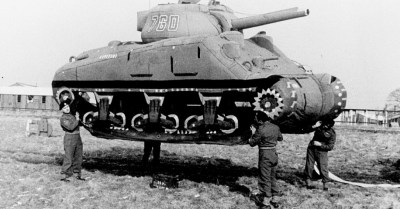 The 603rd Camouflage Engineers had spent much of the war effort hiding men and equipment. There is a lot more to camouflage than fatigue pants. Those random looking color splotches used on troop uniforms aren’t really so random. They are carefully created by artists to match the prevalent terrain in the conflict area. The camoufleurs didn’t just create patterns though. They devised ways of hiding equipment in the natural environment. If the terrain was rocky, rocks were employed to hide concrete pillboxes. Many of the 603rd’s men were artists drafted from schools in New York. They could be found sketching any spare moment they had. This would make the Ghost Army’s non-secret day-to-day activities some of the most well documented in the war.
The 603rd Camouflage Engineers had spent much of the war effort hiding men and equipment. There is a lot more to camouflage than fatigue pants. Those random looking color splotches used on troop uniforms aren’t really so random. They are carefully created by artists to match the prevalent terrain in the conflict area. The camoufleurs didn’t just create patterns though. They devised ways of hiding equipment in the natural environment. If the terrain was rocky, rocks were employed to hide concrete pillboxes. Many of the 603rd’s men were artists drafted from schools in New York. They could be found sketching any spare moment they had. This would make the Ghost Army’s non-secret day-to-day activities some of the most well documented in the war.
As part of the Ghost Army, the men of the 603rd were given a monumental task. Create the illusion, from ground or air, of entire units of tanks, soldiers, trucks, and artillery. The problem was that “fake” tanks, trucks, and artillery were still being designed and built! While waiting for their props, the group created artillery pieces from canvas, metal, and wood they had on hand. The group knew that having the actual dummies was only half the battle. A few tanks sitting in a field wouldn’t fool anyone. The tanks needed to look like they were being camouflaged. There needed to be all the trappings soldiers on the move from headquarters tents to sleeping bags to laundry.
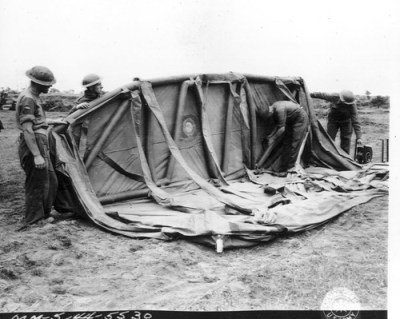 While the 603rd dressed the set, the major props were still being designed. The army tried several different types, eventually choosing an inflatable design created by Fred Patton of the U.S. Rubber Company in Woonsocket, Rhode Island. Rubber was a huge industry in World War II. U.S. Rubber was already operating at capacity building barrage balloons. Most of the work was performed by women.
While the 603rd dressed the set, the major props were still being designed. The army tried several different types, eventually choosing an inflatable design created by Fred Patton of the U.S. Rubber Company in Woonsocket, Rhode Island. Rubber was a huge industry in World War II. U.S. Rubber was already operating at capacity building barrage balloons. Most of the work was performed by women.
Fred Patton had already created a name for himself by designing emergency life rafts used by fighter pilots in the pacific theater. The tanks he created for the Ghost Army needed to be light, fast to deploy, and most of all look like the real thing. The final design was a truss-like skeleton of inflated rubber tubes covered with a painted rubber tarp. The tanks weighed in at 93 lbs, and were easily lifted by four men. Trucks, artillery guns, even planes were all manufactured using the same methods. Hundreds of dummies were built by U.S. Rubber, GoodYear, and several other companies. As fast as they could be made they were shipped to the 603rd.
Sonic Deception
 3132 Signal Service Company’s weapon of choice was an M3A1 half-track with 500 watt speakers mounted in the bed. These specially modified vehicles were designed with stealth in mind. The speakers could be stowed down inside the bed, leaving a vehicle that looked like any of the thousands of other half-tracks in the european theater. When the time came to deploy, the entire system was cranked up using a hand crank system. The soldiers quickly dubbed the crank “The coffee grinder”. Sound playback was a problem. Records would skip if bumped, or if a shell landed nearby. Magnetic tape wasn’t yet available. The solution was state of the art (at the time) wire playback units. These players used a .0006 inch steel wire as the recording medium. Achieving any kind of fidelity required high-speed, so the wire moved at 5 feet per second. Spools were 2 miles, giving 30 minutes of playback. Each half-track was fitted with two players, allowing the operators to switch spools of one machine while the other played. As one might imagine, a wire that thin, moving that fast could – and did break. The field fix was to tie a knot in the wire and hold a match underneath it.
3132 Signal Service Company’s weapon of choice was an M3A1 half-track with 500 watt speakers mounted in the bed. These specially modified vehicles were designed with stealth in mind. The speakers could be stowed down inside the bed, leaving a vehicle that looked like any of the thousands of other half-tracks in the european theater. When the time came to deploy, the entire system was cranked up using a hand crank system. The soldiers quickly dubbed the crank “The coffee grinder”. Sound playback was a problem. Records would skip if bumped, or if a shell landed nearby. Magnetic tape wasn’t yet available. The solution was state of the art (at the time) wire playback units. These players used a .0006 inch steel wire as the recording medium. Achieving any kind of fidelity required high-speed, so the wire moved at 5 feet per second. Spools were 2 miles, giving 30 minutes of playback. Each half-track was fitted with two players, allowing the operators to switch spools of one machine while the other played. As one might imagine, a wire that thin, moving that fast could – and did break. The field fix was to tie a knot in the wire and hold a match underneath it.
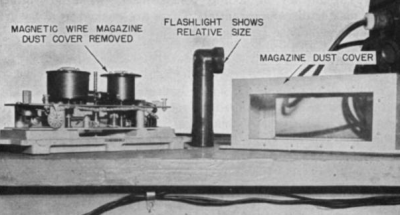 While the half-tracks were being built, Bell Labs was brought in to create the recordings. An entire mobile studio with 16 inch transcription disc recorders was sent down to Fort Knox. They recorded tanks, trucks, and men working. A number of technical issues had to be overcome to get a recording which would hold up on the battlefield. Simply driving a truck past the microphone would create a Doppler effect, and the recording would be instantly recognized as a fake. The solution to this was ingenious: place the microphone at the center of a circle and drive the trucks around it. The trucks would always be equidistant from the microphone, so there would be no Doppler effect.
While the half-tracks were being built, Bell Labs was brought in to create the recordings. An entire mobile studio with 16 inch transcription disc recorders was sent down to Fort Knox. They recorded tanks, trucks, and men working. A number of technical issues had to be overcome to get a recording which would hold up on the battlefield. Simply driving a truck past the microphone would create a Doppler effect, and the recording would be instantly recognized as a fake. The solution to this was ingenious: place the microphone at the center of a circle and drive the trucks around it. The trucks would always be equidistant from the microphone, so there would be no Doppler effect.
To create the wire recordings used by the Ghost Army, several records were mixed together. If the deception included a river crossing, sounds of men assembling a pontoon bridge would be mixed in with the tanks, trucks, and other equipment. This was an early example of multi-track recording.
Sound travels differently depending on wind, temperature, and other weather conditions. The Ghost Army had to handle this. A jeep mounted weather station was deployed on each mission. Weather data was compared to a book of firing tables created by Bell Labs. Much like the tables used by gunners, these numbers helped the Ghost Army determine the correct direction and volume for their playback.
Radio Deception
The Signal Company Special were a handpicked group of radio operators. Their job was to send carefully scripted radio traffic to mislead the enemy. It wasn’t just a matter of sending the transmissions though. They had to mimic the equipment and men of the divisions they were impersonating.
Anyone who has listened to ham radio operators communicate by Morse code can tell you that no two hams are alike. Some are slow and plodding, while others are a quick staccato beat of dits and dahs. Every radio operator has a style, just like everyone has a fingerprint. During the war the term for this was “fist”. The Germans radio monitoring corps knew the fists of each unit, and would be tipped off if new operators were suddenly on the scene. The Signal Company Special had to learn and mimic the fist of the real radio operators for the battle groups they were impersonating.
Transmission power was another issue. The Signal Company Special had powerful transmitters. The Germans would quickly catch on if they saw their received signal strength indicators (RSSI) jump as the Ghost Army went on the air. While the company didn’t have transmitter power meters, they did have pencils. Holding a pencil near a transmitting antenna would cause a spark to jump from the antenna to the pencil. More power would cause a longer spark. The team simply set their transmitter power levels to match the spark length of the original equipment.
Wartime Operations
The 23rd Headquarters Special Troops worked for over a year in France, Germany, and Luxembourg and other European nations. They would create deceptions – sometimes several at once, placing Allied groups in places they simply didn’t exist. Captured German intelligence proved again and again that these deceptions were successful. The men were also some of the bravest of the war. Think about it – standing in a war zone surrounded by inflatable tanks designed to deceive the enemy. If the Germans had attacked, the only real weapons the 23rd had were a few truck-mounted machine guns and their sidearms. The army of course had considered this possibility. Much of the 23rd’s equipment, most notably the sonic half-tracks, were wired with explosives. If it looked like the enemy was going to overrun them, the men were to pull a lever. They would then have 15 seconds before the charges detonated, blowing up the secret equipment before it could fall into German hands. Thankfully the charges were never needed.
Operation Viesen
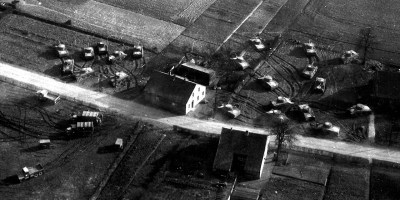 Of all the Ghost Army’s operations, the one they are most remembered for is their final deception. Operation Plunder was the codename for the crossing of the Rhine River on March 23, 1945. For nearly a week before Plunder, the 23rd carried out Operation Viersen, an effort to convince the Germans that the crossing would take place 10 miles south of the actual location. Eleven hundred men were impersonating two divisions of the Ninth army – a force thirty thousand strong. An entire airfield complete with an inflatable L-5 observation plane was created. It was realistic enough that an actual L-5 landed there, much to the chagrin of the pilot. Inflatible guns were erected and constantly monitored. Any leaks would cause the barrels to droop, which would certainly tip-off the Germans. The 23rd’s spoof radio operators coordinated with their real counterparts. As the real divisions went off the air, the 23rd came on. The transfer was seamless. The Germans had no idea they were being duped.
Of all the Ghost Army’s operations, the one they are most remembered for is their final deception. Operation Plunder was the codename for the crossing of the Rhine River on March 23, 1945. For nearly a week before Plunder, the 23rd carried out Operation Viersen, an effort to convince the Germans that the crossing would take place 10 miles south of the actual location. Eleven hundred men were impersonating two divisions of the Ninth army – a force thirty thousand strong. An entire airfield complete with an inflatable L-5 observation plane was created. It was realistic enough that an actual L-5 landed there, much to the chagrin of the pilot. Inflatible guns were erected and constantly monitored. Any leaks would cause the barrels to droop, which would certainly tip-off the Germans. The 23rd’s spoof radio operators coordinated with their real counterparts. As the real divisions went off the air, the 23rd came on. The transfer was seamless. The Germans had no idea they were being duped.
As with all the 23rd’s operations, the group had no idea if their plan was working until the day of the actual attack. Success would mean little or no defense. Failure would mean heavy casualties for the attacking divisions. In the case of Plunder, things went perfectly. The Allies crossed at the town of Rees, and found only a few disorganized German defenders. Captured German maps showed the ninth army groups exactly where the 23rd’s deception placed them. General William Simpson, ninth Army Commander, wrote a letter commending the 23rd for their efforts. For the men of the Ghost Army, the hardest part of the war was over.
After the war
Many of the men of the 23rd went on to live successful lives as artists, illustrators, designers, and engineers. The most famous member was clothing designer Bill Blass. Many of them didn’t live long enough to share their stories though. The deceptions which worked against the Germans were considered vital tools of the Cold War. The Ghost Army’s operations remained largely classified for 40 years.
Sources
Numerous media articles and several books have been written about the Ghost Army. One of the more notable ones is “The Ghost Army of World War II: How One Top-Secret Unit Deceived the Enemy with Inflatable Tanks, Sound Effects, and Other Audacious Fakery” by Rick Beyer and Elizabeth Sayles. This book and Beyer’s hour long PBS documentary drew largely from a decade of interviews with the men of the 23rd. The book is an incredible read, and highly recommended.

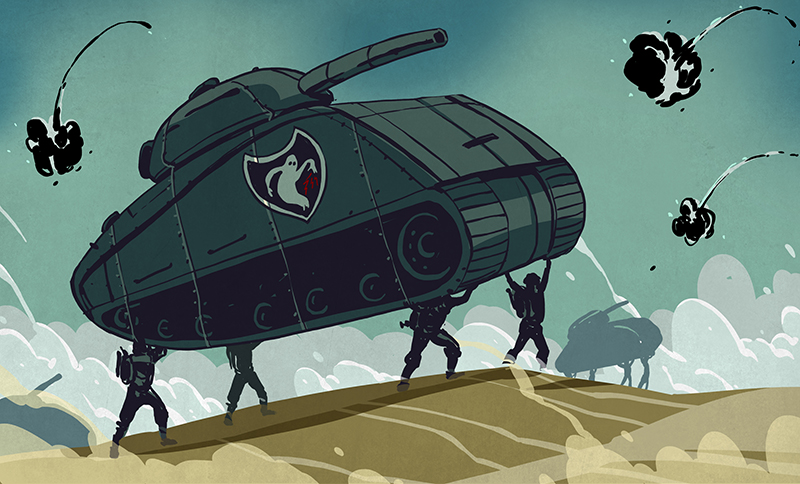















Hackaday, first supporter of lost US army superiority nostalgia.
US army budget: 581 billions of dollars in 2014.
Wars won: none, since WWII
the whole middle-east is in a blood bath.
can´t you stop showing off the US army penises, dear Kackaday ?
bin, some of the best retro-tacular articles only exist due to the US military. Kindly get bent.
Bhelliom, This is an awesome topic. For one to feel shafted at the narrow field this article represents is quite understandable. Keep sheepn it bhelliom. Propaganda’s gotta work on someone, right?
Have someone precheck articles for you. It’ll save you clutching at your pearls and having palpitations. And save the rest of us from your whining.
Cool your beans, they were doing it under instruction of fine upstanding Brits so it’s all good.
Also, some of the most ingenious ideas mankind has ever had have come about through the necessities of war.
Lol, and even more so at all the replies
In fiction, this sort of deception features in both Stephenson’s “Cryptonomicon” and Willis’ “Blackout”/”All Clear”
Not really for cryptonomicon (haven’t read the other): The unit Waterhouse and Shaftoe are with is specifically to ‘widen the bell curve’; to deny the enemy statistical proof that their crypto systems have been broken. That is indeed still deception, but much more subtle. It did not involve faking entire divisions/armies.
And thanks to Churchill Poland would be occupied by soviets for the next ~45 years. He’s no hero, he’s a criminal.
You are right. Churchill should have left Poland to the nazis.
At least germans were civilized. When german officer stopped at my grandpa’s farm he ate a dinner, had some rest and generally did nothing wrong. Soldiers from his unit were also normal people, not murderous thugs. Then few years later soviets came to “free” us from german occupation. They killed all farm animals for no reason, tried to sharpen silver knives and forks, ate butter with bare hands and one soldier stole and tried to wear an alarm clock… Life under german rule wasn’t that bad (unless you were a jew or a partizan). Soviet “help” was just plain misery for everyone. WWII is not as black-and-white as you might think.
@aeg “At least germans were civilized”
Tell that to the people of Warsaw, Starogard Gdański, Wola, Szczurowa, Ochota, and Lviv. Also be sure to mention it to everyone who went through Treblinka, Sobibór, Auschwitz, Auschwitz II–Birkenau, and Bełżec.
Not saying what the Soviets did wasn’t horrible to the Nth degree, nor excusing the western allies for allowing it, nor diminishing the valor and sacrifice of those who fought and too-often died opposing the Soviet oppression, but to call the Nazis “civilized” is a crime before God and human decency. It gives the reader the sense that your post was written by the kind of person who’d say “eh, not so bad if you weren’t Jewish” as they typed.
Re-read your post, noticed the parenthetical I’d missed before. Now I regret not ending my post with “you giraffe fucker.”
Maybe you just have a different definition of the word ‘civilized’. Do you think that being civilized means being nice to everyone? To be civilized is to conform to your own civilization. Civilization is just the group mind you get when a large group of humans come together. Humans are a particularly nasty pack animal that does not do nice things to individuals that are outside their own pack.
It’s amazing how little time it takes for people to forget.
https://en.wikipedia.org/wiki/Generalplan_Ost
Really? This is a “featured” article?
How far HAD has fallen. Anything for a click-through, right?
The ghost army HACKED a WAR. That’s the biggest hack I ever have seen.
All hacks are not electronic in nature. Some are social. re: ISIS
I loved this article – nicely written and on a cool subject that I hadn’t heard about before. Sad that you don’t feel the same, but there is lots of content to choose from so hopefully you find the stuff you like in there somewhere :)
I actually think this is a pretty cool article. The use of 1940s technology to make recordings sound as “natural” as possible is pretty clever.
I for one really liked it.
although I have already read about this. I still read every word, It was one of the greatest confidence tricks the world has ever seen. The people that are saying “This isn’t a hack” let me explain, This is a hack the inflatibles and sound managed to “Hack” the brains of the enemy they passed off fakes as real.
I don’t know why some people are hating this article. It’s great so Thanks Adam.
Thanks Jack! No article will please every reader. I do my best though :)
Nice one, Adam. Loved it! Thanks!
If you have access to Netflix. There is documentary of the ghost army. Very, very good.
They deceived the Germans into holding back instead of breaking through a totally undefended front. They were too good at there job, they came under attack and almost unmasked their deception. They even up-supported small sectors to look way beyond their strength.
Got Netflix, watch it.
That’s Rick Beyer’s documentary (The one mentioned at the end of the article). Seriously – it’s a must watch. Many great interviews with the soldiers who were there.
This was a good deception, but I thought an even better one was when the British tricked the Germans into bombing a fake Alexandria.
Is that one actually true? You see for years a stage magician by the name of Jesper Maskelyne went round telling the world how he had done that and invented innumerable weird machines in the process. He got away with it because most of the records that would have showed him up as a bullshitter were classified. There was even talk about ten or fifteen years ago that Tom Cruise was looking to make a film about his life story, which all fell apart when they started to hunt for stuff that would corroborate what he said in his autobiography. In some ways it’s an equally fascinating deception as the story above
I can’t help but wonder if someone when testing the sound “weapons” stateside didn’t put on some hot jazz like Louie Jordan or Duke Ellington and crank it way up and liven up the base. But there was a war going on.
For all those against this article: I find it fascinating. And this is used even now, in war torn Middle East. Heck, while bombing Yugoslavia in 1999, a F-117a (stealth plane) was shot down. His job was to bomb tanks. Fake tanks – http://www.cracked.com/article_19929_the-6-craziest-disguises-ever-used-in-history-war_p2.html Some of them even used small furnaces to give heat signature, and fake SAMs used microwave ovens to fool airplane radars.
Russia has dummy equipment: http://www.fyjs.cn/thread-359465-1-1.html
I would be surprised if US and other NATO countries don’t use such technology.
After the war, wire recording instantly became obsolete when the rest of the world discovered that Germans had invented plastic magnetic recording tape and it was not only much easier to handle (wouldn’t cut fingers like the thin wire), it worked at a much lower speed.
For a long time, until and even after the rise of Japan’s electronics industry, German made tape and recording equipment was widely considered to be the best.
The Nazis were able to “encrypt” radio transmissions for a while simply by recording onto tape then playing them back at high speed. The transmissions were recorded at the receiver at high speed then played back at normal speed. Eventually someone on the Allied side figured out the trick and used wire recorders to capture and slow the messages down. Of course in short order the Nazis figured out that the method had been cracked so they went to using real codes.
How does the wire store the audio? is it magnetic or physical (small scratches like a record)?
Wire is magnetic, same as tape. However, unlike tape, you get problems like twist. https://en.wikipedia.org/wiki/Wire_recording
I often had problems with twist on 8-track cartridges and audio cassettes. B^)
I thought the enigma machine was a Swiss design that the German Military adapted rather than created.
In fact, afaik the Enigma was originally a Dutch design for commercial use, later bought by the Germans and adapted for Swiss use too (as well as Japanese and Italian variations being produced).
There are a lot of great tech aspects to The Ghost Army story. Leo Beranek of Bolt Berank and Newman, still alive at age 101, was involved in testing speakers for Ghost Army use. Here’s a video clip about that: https://www.youtube.com/watch?v=dQECgHkxZLI
Yes! Leo created the first anechoic chamber (and coined the term) during his ghost army testing. Amazing work in its own right.
theres an excellent documentary on this on Netflix. Artists ranging from musicians to comic strip creators were brought into this.
I think one of the greatest deceptions had to be FUSAG, the First U.S. Army Group, an entire fictional army under the command of General Patton (where he was assigned after he slapped a soldier but before D-Day) . The entire deception was to make the Germans think D-Day would come (as Hitler said) at Pas de Calais. The Germans fell for it so fully they had reserves held back for Calais for possibly weeks after D-Day, FUSAG was a bloody master stroke.
https://en.wikipedia.org/wiki/First_United_States_Army_Group
I might get that patch for a jacket too.
Adam, who did the great illustration for this article? Wold love to get a print.
The Soviets pulled off some pretty clever deceptions too, on the Eastern front. Fake radio chatter and troop movements, designed to keep the Germans from figuring out where on a colossally long front the actual push would happen. It’s all about manipulating the enemy to keep them from leveraging their strengths against your own weaknesses. Just too bad the end result is dead people.
Flashing forward to today, I’ve read of separatists in Ukraine taking “artillery positions” only to find artfully-arranged piles of logs.
Interesting personal connection for me as my grandmother worked for Uniroyal in Providence, RI back during WWII. One of her jobs was making inflatable pieces of “something” for the army. She and the other women working there were never told what the end product was, but she did mention it was a job from US Rubber that they couldn’t scale up to manufacture.
Also one correction to the article, I believe the correct spelling for the designer should be, Fred Patten.
As a retired Army officer, this article about the Ghost Army is superb. No one will ever know the countless number of allied soldiers these 1,100 men saved through their innovative ideas and their strict attention to detail. Without being melodramatic, I salute these men and their units for their contribution to the allied victories during WW II. Cam S.